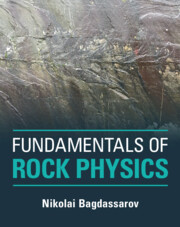Book contents
- Fundamentals of Rock Physics
- Fundamentals of Rock Physics
- Copyright page
- Dedication
- Contents
- Preface
- 1 Introduction
- 2 Density and Porosity
- 3 Stresses in Rocks
- 4 Mechanical Strain and Elastic Moduli
- 5 Permeability of Rocks
- 6 Mechanical Properties of Fluid-Bearing Rocks
- 7 Acoustic Properties of Rocks
- 8 Electric Resistivity
- 9 Dielectric Properties
- 10 Magnetic Properties of Rocks
- 11 Thermal Properties of Rocks and Minerals
- 12 Radioactive Properties of Rocks
- Index
- References
10 - Magnetic Properties of Rocks
Published online by Cambridge University Press: 19 November 2021
- Fundamentals of Rock Physics
- Fundamentals of Rock Physics
- Copyright page
- Dedication
- Contents
- Preface
- 1 Introduction
- 2 Density and Porosity
- 3 Stresses in Rocks
- 4 Mechanical Strain and Elastic Moduli
- 5 Permeability of Rocks
- 6 Mechanical Properties of Fluid-Bearing Rocks
- 7 Acoustic Properties of Rocks
- 8 Electric Resistivity
- 9 Dielectric Properties
- 10 Magnetic Properties of Rocks
- 11 Thermal Properties of Rocks and Minerals
- 12 Radioactive Properties of Rocks
- Index
- References
Summary
Dia, para- and ferromagnetism of rocks and minerals correspond to the wide range of magnetic susceptibility. Atomistic models of dia- and paramagnetism are considered. The Langevin function describes magnetic saturation of paramagnetic particles, whose magnetic susceptibility depends on temperature according to the Curie–Weiß law. Ferromagnetism, antiferromagnetism, ferrimagnetism and canted antiferromagnetism are considered. Ferromagnetic minerals are characterized by magnetic domains whose boundaries experience Barkhausen jumps during magnetization-demagnetization. Magnetic domains are separated by Bloch walls. Koenigsberg’s ratio, i.e. the ratio of induced and remanent magnetizations, depends on the shape demagnetization factor a The concept of locking temperature based on the magnetization relaxation time is used to reconstruct paleomagnetic fields, i.e. in the case of magnetic stripes of mid-oceanic ridge basalts. Principles of chemical, pressure and detrital-remanent magnetization. Focus Box 10.1: Magnetic field of a small dipole. Focus Box 10.2: Brillouin function. Focus Box 10.3: Electron shells, orbitals and orbital hybridization. Focus Box 10.4: Extended Weiss model.
Keywords
- Type
- Chapter
- Information
- Fundamentals of Rock Physics , pp. 414 - 454Publisher: Cambridge University PressPrint publication year: 2021

